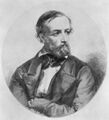Template:Selected anniversaries/May 5: Difference between revisions
No edit summary |
No edit summary |
||
| Line 17: | Line 17: | ||
||1861: Peter Cooper Hewitt born ... electrical engineer who invented the mercury-vapour lamp, an important forerunner of fluorescent lamps. He studied the production of light using electrical discharges (while Thomas Edison was still developing incandescent filaments). The mercury-filled tubes he developed from the late 1890s, gave off an unattractive blue-green light. Although unsuitable in homes, its brilliance won wide adoption by photo studios because the black and white film of the time needed just bright light, despite its colour. There were many other industrial uses for the lamp. His manufacturing company (est. 1902) was bought by General Electric in 1919 which produced a new design in 1933. He took out his first eight mercury vapour lamp patents on 17 Sep 1901. Pic. | ||1861: Peter Cooper Hewitt born ... electrical engineer who invented the mercury-vapour lamp, an important forerunner of fluorescent lamps. He studied the production of light using electrical discharges (while Thomas Edison was still developing incandescent filaments). The mercury-filled tubes he developed from the late 1890s, gave off an unattractive blue-green light. Although unsuitable in homes, its brilliance won wide adoption by photo studios because the black and white film of the time needed just bright light, despite its colour. There were many other industrial uses for the lamp. His manufacturing company (est. 1902) was bought by General Electric in 1919 which produced a new design in 1933. He took out his first eight mercury vapour lamp patents on 17 Sep 1901. Pic. | ||
File:Charles Grafton Page.jpg|link=Charles Grafton Page (nonfiction)|1868: Inventor, physician, chemist [[Charles Grafton Page (nonfiction)|Charles Grafton Page]] dies. His work had a lasting impact on telegraphy and in the practice and politics of patenting scientific innovation, challenging the rising scientific elitism that maintained 'the scientific do not patent'. | File:Charles Grafton Page.jpg|link=Charles Grafton Page (nonfiction)|1868: Inventor, physician, chemist [[Charles Grafton Page (nonfiction)|Charles Grafton Page]] dies. His work had a lasting impact on telegraphy and in the practice and politics of patenting scientific innovation, challenging the rising scientific elitism that maintained 'the scientific do not patent'. | ||
| Line 33: | Line 31: | ||
||1905: The trial in the Stratton Brothers case begins in London, England; it marks the first time that fingerprint evidence is used to gain a conviction for murder. | ||1905: The trial in the Stratton Brothers case begins in London, England; it marks the first time that fingerprint evidence is used to gain a conviction for murder. | ||
File:Lazarus Immanuel Fuchs.jpg|link=Lazarus Fuchs (nonfiction)|1833: Mathematician and academic [[Lazarus Fuchs (nonfiction)|Lazarus Immanuel Fuchs]] born. He will contribute important research in the field of linear differential equations. Fuchs will be the eponym of Fuchsian groups and functions, and the Picard–Fuchs equation. | File:Lazarus Immanuel Fuchs.jpg|link=Lazarus Fuchs (nonfiction)|1833: Mathematician and academic [[Lazarus Fuchs (nonfiction)|Lazarus Immanuel Fuchs]] born. He will contribute important research in the field of linear differential equations. Fuchs will be the eponym of Fuchsian groups and functions, and the Picard–Fuchs equation. | ||
| Line 51: | Line 47: | ||
||1940: Georg von Arco dies ... physicist, radio pioneer, and one of the joint founders of the "Society for Wireless Telegraphy" which became the Telefunken company. He was an engineer and the technical director of Telefunken. He was crucial in the development of wireless technology in Europe. Pic. | ||1940: Georg von Arco dies ... physicist, radio pioneer, and one of the joint founders of the "Society for Wireless Telegraphy" which became the Telefunken company. He was an engineer and the technical director of Telefunken. He was crucial in the development of wireless technology in Europe. Pic. | ||
||1945: World War II: Six people are killed when a Japanese fire balloon explodes near Bly, Oregon. They are the only Americans killed in the continental US during the war. | ||1945: World War II: Six people are killed when a Japanese fire balloon explodes near Bly, Oregon. They are the only Americans killed in the continental US during the war. | ||
| Line 73: | Line 67: | ||
File:Mendel Sachs.jpg|link=Mendel Sachs (nonfiction)|2012: Theoretical physicist [[Mendel Sachs (nonfiction)|Mendel Sachs]] dies. His work included the proposal of a unified field theory that brings together the weak force, strong force, electromagnetism, and gravity. | File:Mendel Sachs.jpg|link=Mendel Sachs (nonfiction)|2012: Theoretical physicist [[Mendel Sachs (nonfiction)|Mendel Sachs]] dies. His work included the proposal of a unified field theory that brings together the weak force, strong force, electromagnetism, and gravity. | ||
</gallery> | </gallery> | ||
Revision as of 22:02, 26 January 2022
1580: Mathematician Johann Faulhaber born. He will discover Faulhaber's formula, which expresses the sum of the p-th powers of the first n positive integers.
1859: Mathematician Peter Gustav Lejeune Dirichlet dies. He made important contributions to number theory, analysis, and mechanics. Dirichlet was one of the first mathematicians to give the modern formal definition of a function.
1868: Inventor, physician, chemist Charles Grafton Page dies. His work had a lasting impact on telegraphy and in the practice and politics of patenting scientific innovation, challenging the rising scientific elitism that maintained 'the scientific do not patent'.
1833: Mathematician and academic Lazarus Immanuel Fuchs born. He will contribute important research in the field of linear differential equations. Fuchs will be the eponym of Fuchsian groups and functions, and the Picard–Fuchs equation.
1933: The New York Times The New York Times publishes a front-page account of a scientific paper on radio astronomy by Karl Guthe Jansky.
2012: Theoretical physicist Mendel Sachs dies. His work included the proposal of a unified field theory that brings together the weak force, strong force, electromagnetism, and gravity.





